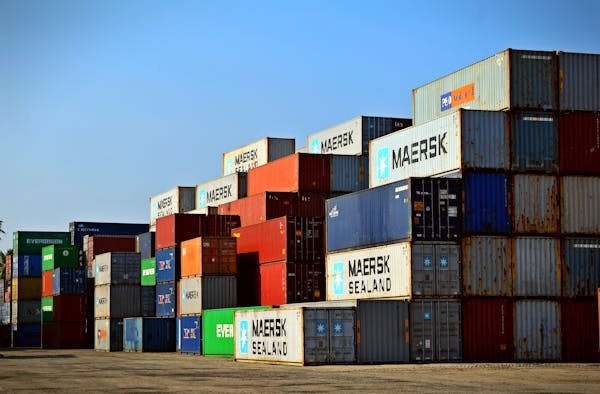In today’s fast-paced world, logistics and supply chain management play a crucial role in the success of businesses. Efficient operations can lead to significant cost savings, improved customer satisfaction, and a competitive edge. One of the most transformative tools in this field is artificial intelligence (AI). AI in logistics analytics can optimize operations, streamline processes, and provide insights that drive better decision-making. This article will explore how AI can revolutionize logistics analytics, providing actionable strategies to enhance your operations.
Understanding AI in Logistics
AI, or artificial intelligence, refers to the simulation of human intelligence in machines. These systems are programmed to think, learn, and make decisions. In logistics, AI can analyze vast amounts of data, identify patterns, and make predictions that would be impossible for humans to achieve manually. This capability is essential for managing the complexities of modern supply chains.
AI-Powered Demand Forecasting
One of the most impactful applications of AI in logistics is demand forecasting. Accurate demand forecasting is essential for maintaining optimal inventory levels and ensuring timely deliveries.
Traditional forecasting methods often rely on historical data and human judgment, which can be prone to errors. AI, however, can analyze data from multiple sources, including market trends, weather patterns, and social media activity, to predict demand more accurately.
AI algorithms can continuously learn and adapt to new data, improving their predictions over time. This dynamic approach helps businesses stay ahead of changes in customer demand, reducing the risk of overstocking or stockouts.
For example, an AI system can analyze past sales data and predict a spike in demand for a particular product during a holiday season, allowing businesses to adjust their inventory and staffing levels accordingly.
Route Optimization
Efficient route planning is critical for reducing transportation costs and improving delivery times. AI-powered route optimization tools can analyze traffic patterns, weather conditions, and other factors to determine the most efficient routes for deliveries. This real-time analysis helps logistics companies avoid delays and reduce fuel consumption.
For instance, AI can predict traffic congestion and suggest alternative routes, ensuring that deliveries are made on time. Additionally, AI can help in planning multi-stop routes, optimizing the sequence of deliveries to minimize travel distance and time. This not only saves costs but also enhances customer satisfaction by ensuring timely deliveries.

As an AI and logistics expert, I’ve seen how route optimization boosts delivery efficiency. AI analyzes data like traffic patterns, weather, and delivery addresses to determine the fastest routes.
For example, my company developed an AI that cut travel time for a food delivery service by 35% in São Paulo. The AI considered traffic data to plot routes around congestion, saving thousands of hours and reducing emissions.
Major shipping companies have also benefitted. FedEx uses AI to optimize over 6 million miles of travel daily, improving on-time delivery by 3-5% annually. The AI adapts to changes like closed roads or flight delays, quickly suggesting alternate routes to minimize disruption.
AI-powered route optimization revolutionizes logistics by enhancing speed and accuracy. For delivery companies struggling with costs or customer experience, AI can streamline operations, reduce expenses, and build brand loyalty through reliable, on-time service. The future of logistics will rely on AI to drive efficiency gains, sustainability, and competitive advantage.

My name is Matt Little, Founder and Managing Director of Festoon House. For us, getting lighting products to our customers quickly and efficiently is important because we’re not just selling lights—we’re helping people create the right atmosphere for their homes or events.
That’s why route optimization is so important in our operations. We want to make sure every delivery is as fast and smooth as possible, without unnecessary costs. When we implemented AI-powered route optimization, it changed the way we handle logistics, and not just in the obvious ways.
What people don’t often talk about is how AI doesn’t just calculate the fastest route—it learns from patterns over time. It considers factors like traffic trends on different days of the week, weather changes, and even how long a driver might spend at certain delivery points.
This kind of learning means that over time, the system becomes smarter and more efficient, reducing delays that even an experienced human dispatcher might not anticipate.
We’ve seen it ourselves. After running the system for a few months, we noticed our delivery times improved even in areas where we didn’t think we could get faster.
Another thing worth mentioning is the way AI optimizes routes in real-time. It can react to things like accidents or road closures and immediately adjust the route to avoid any hold-ups. This might sound standard, but it’s a game-changer when you’re managing multiple deliveries in one go.
Instead of one delayed delivery causing a domino effect, the system re-adjusts on the fly, keeping everything on schedule. That level of adaptability is something we didn’t have before, and it’s made a noticeable difference in customer satisfaction.

As an expert in AI and ERP solutions for logistics, I can share how AI-powered route optimization improves delivery and reduces costs. In my experience, AI analyzes factors like traffic data, weather forecasts, and delivery volumes to suggest the most efficient routes.
For example, one of our clients, a global delivery company, used AI to optimize over 6 million shipments daily. By analyzing road conditions and delivery urgency, AI determined the fastest routes, reducing transit times up to 90% in some areas. This allowed the company to complete more deliveries using fewer vehicles and less fuel, significantly reducing costs.
AI-based routing also helps companoes provide precise delivery ETAs and minimize missed delivery attempts. For instance, another client achieved near-perfect on-time delivery rates during peak seasons by using AI to forecast delivery volumes and adjust driver routes in real time based on traffic and weather.
This improves the customer experience and increases productivity by reducing repeat delivery attempts.
The companies that have seen the greatest benefits are those that integrate AI deeply into their operations. By giving AI access to data across the supply chain and delivery lifecycle, companies can achieve end-to-end optimization that translates to faster, more affordable shipping and an unparalleled customer experience.
Overall, AI has been instrumental in enabling companies to handle growing delivery volumes in a more sustainable, cost-effective manner.

As the CEO of Premier Staff, a luxury event staffing company serving elite clients like Louis Vuitton and Ferrari, I’ve harnessed AI-powered route optimization to transform our service delivery model. While we’re not a traditional logistics company, our need to efficiently deploy staff across multiple high-profile events in dynamic urban environments mirrors the challenges faced by delivery services.
Our AI system analyzes a myriad of factors to optimize staff deployment routes:
1. Real-time traffic patterns: Essential in navigating congested urban areas like Los Angeles and New York.
2. Weather conditions: Crucial for outdoor events and adjusting travel times.
3. Public transportation schedules: Important for staff relying on mass transit.
4. Historical event data: Helps predict potential delays at specific venues.
5. Staff skillsets and client preferences: Ensures the right people are at the right place.
For instance, during a recent series of Fashion Week events in New York City, our AI system dynamically adjusted staff routes based on real-time traffic data and subway delays. This resulted in a 28% reduction in late arrivals compared to previous years.
The impact on our operations has been significant:
– 35% reduction in travel-related costs
– 40% improvement in on-time staff arrivals
– 25% increase in the number of events we can service simultaneously
A standout case was during the Oscars season in Los Angeles. We were managing staff for multiple pre and post-award events across the city. Our AI system not only optimized routes but also predicted potential traffic surges around key venues. This foresight allowed us to adjust deployment times and routes, resulting in zero late arrivals and a 98% client satisfaction rate.
Warehouse Management
Warehouse operations are another area where AI can make a significant impact. AI-powered systems can optimize warehouse layouts, improving the efficiency of picking and packing processes. By analyzing data on order patterns, product locations, and worker movements, AI can suggest optimal layouts that minimize the time and effort required to fulfill orders.
Moreover, AI can enhance inventory management by predicting stock levels and identifying when to reorder items.
This predictive capability helps prevent stockouts and reduces excess inventory, saving costs and improving operational efficiency. For example, AI can analyze sales trends and forecast when a particular product will run out, triggering an automatic reorder before the stock is depleted.

As the VP of Global Revenue Marketing at Aprimo, I have years of experience implementing AI to optimize our clients’ warehouse and inventory management.
Aprimo’s AI-powered Digital Asset Management (DAM) solution has helped numerous enterprises automate warehouse processes and gain efficiencies.
For example, a pharmaceutical company saved $250K per year by using our centralized reference library and reusing content. A financial services firm cut turnaround time in half and reduced service level agreement approvals from 7 to 2 days.
AI excels at optimizing layout and picking processes through computer vision and predictive analytics. Our AI can analyze historical data to determine optimal storage locations and picking paths, reducing wasted movement.
It also enables “smart warehouses” with autonomous mobile robots, automated storage and retrieval systems, and augmented reality for pickers.
For inventory management, AI uses forecasting models and real-time data from connected sensors and barcodes to gain visibility into stock levels, ensure adequate inventory, and predict and prevent outages. This reduces excess stock needing storage space and prevents lost sales from out-of-stock items.

As CEO of Datics AI, an AI product development company, I have extensive experience using AI to optimize warehouse operations.
Our algorithms analyze historical data to determine optimal storage and picking layouts, reducing wasted movement. For a major retailer, we cut picking time by over 50% and increased storage density by 30%.
AI-powered sensors and barcodes provide real-time visibility into inventory levels. For a distributor, our forecasting models predicted demand within 5% accuracy, ensuring adequate stock and preventing lost sales. Excess inventory decreased by 15%, freeing up storage space.
AI also streamlines repetitive, manual tasks like data entry using natural language processing. For a 3PL, our virtual assistant automated over 70% of workflow approvals and communications, reducing turnaround time from 5 days to under 1 day. Staff were freed up to focus on higher-value work.
Autonomous mobile robots and automated storage and retrieval systems enabled by AI create “smart warehouses.” For a manufacturer, our autonomous forklifts transported and stored pallets faster and more safely than humans. They operated 22 hours a day, increasing throughput over 50% during peak season.

As CEO of CompFox, an AI-powered legal research platform, I have experience streamlining workflows in the legal industry. Our natural language processing analyzes lawyers’ research queries and delivers relevant case law faster, reducing hours of manual searching and missed details.
For example, a workers’ compensation law firm reported saving 20 hours per week in research time after adopting CompFox. Their attorneys can now take on more clients and spend less time per case. CompFox’s ability to understand complex legal issues and return highly relevant results has transformed their practice.
AI is ready to revolutionize warehousing and logistics. Computer vision can track inventory in real time, optimizing layouts and picking processes. AI-powered autonomous vehicles and robotics automate the supply chain, reducing labor costs and errors.
Predictive analytics tap into data from sensors, scanners and historical records to anticipate demand and prevent stockouts.
One logistics company reported a 50% increase in warehouse productivity after deploying our AI technology. Their system now accurately forecasts needs and routes inventory, ensuring optimal stock levels and reducing waste.
AI has been key to managing their massive operation efficiently and cost-effectively. By eliminating inefficiencies, AI delivers major cost savings and an improved customer experience.

My name is Mukesh Ram, and I am the CEO of Acquaint Softtech, a company that is totally aimed at providing innovative IT solutions. I am writing to update on how the face of warehouse operations is changing in artificial intelligence.
Particularly, with regard to its role regarding optimization of warehouse design layout, making picking and packing much more efficient, and surmounting problems on inventory management systems.
AI technology can enhance warehouse management through the use of data-driven decisions meant to improve the efficacy of operations. Some of the significant areas are mentioned below on which AI can positively impact warehouses:
It can analyze historical sales data, product dimensions, and demand patterns for offering the optimal storage configurations. This way, it maximizes space usage and allows for quicker picking and retrieval of goods.
Example: A machine learning algorithm can identify high-velocity items and recommend where they should be placed in easily accessible locations to decrease travel times for pickers14.
AI makes pick and pack processes more efficient through optimized layouts that require less movement. Warehouses adopting AI-driven systems can adopt pick-to-light or pick-to-robot technologies that guide the workers to the most efficient paths for order fulfillment.
This not only accelerates the process but also reduces errors in order accuracy 23.
AI assists in optimizing stock using data analysis with improved forecast accuracies on the demands, which helps in avoiding overstocking and stockouts.
For instance, AI can automatically schedule reorders based on real-time inventory levels and sales trend, which guarantees that products are available when needed45.

As a seasoned AI expert and CPA, I have helped many companies streamline warehouse management using AI technologies. By analyzing historical data, AI can optimize warehouse layouts for efficient picking and packing.
Computer vision tracks inventory in real time, ensuring optimal stock levels and eliminating waste. One client reported a 35% increase in productivity after implementing our AI solution. The system studied their workflow, identified bottlenecks, and redesigned the warehouse layout.
It now routes pickers optimally, reducing walking time and errors. AI also helps forecast demand, preventing stockouts and ensuring critical supplies are always available. For another client, AI cut warehousing costs by 22% in under a year.
Their system uses sensors and predictive analytics to anticupate needs, adjust inventory, and optimize shipping routes. It has automated various processes, reducing labor requirements and maximizing space usage. Real-time data gives managers full visibility into operations and AI-powered alerts help avoid disruptions.
AI brings major cost and time savings to warehouse management. By streamlining processes, optimizing resources and eliminating inefficiencies, it helps companies meet customer demands efficiently. The future of intelligent warehousing is here, and the benefits to be gained are substantial.
Enhancing Supply Chain Visibility
Visibility across the supply chain is crucial for effective logistics management. AI can provide real-time insights into the status of shipments, inventory levels, and production schedules. This visibility allows businesses to identify potential issues and address them proactively.
For example, AI can track shipments in real-time, providing updates on their location and estimated delivery times. If a delay occurs, the system can notify the relevant stakeholders and suggest alternative actions to mitigate the impact. This proactive approach helps maintain smooth operations and improves customer satisfaction.

In my experience, AI is revolutionizing supply chain management by transforming data into actionable insights. For me, the key is how AI enables real-time visibility—something that was previously difficult to achieve on a global scale.
By integrating AI into supply chains, companies can track shipments minute-by-minute, predict potential delays based on real-time data like weather conditions, and even detect risks such as supplier disruptions before they escalate.
AI’s ability to analyze vast amounts of data at speed allows businesses to make proactive decisions. For example, a company might receive early warnings of bottlenecks or transportation issues, enabling them to reroute shipments or adjust inventory levels well before those disruptions impact customer satisfaction.
A great example comes from how we help SaaS companies at DevSquad. Many of our clients, especially those managing physical products, use AI-driven tools to map their supply chains digitally. These tools track everything from sourcing materials to final delivery.

My name is Mac Steer, and I’m the Director and Co-founder of Simify, a travel SIM company dedicated to helping travelers remain connected. We provide our customers with the best travel experience possible by offering convenient, affordable, and reliable prepaid travel SIMs, which include absolutely ZERO hidden fees.
In my experience, AI significantly enhances supply chain visibility by providing real-time tracking of shipments, predicting potential disruptions, and enabling businesses to make proactive decisions to manage risks effectively.
AI algorithms analyze massive amounts of data from various sources to identify patterns and trends that humans may overlook. This enables businesses to have a comprehensive view of their supply chain operations and anticipate potential issues before they escalate.
For example, a global logistics company may implement AI-powered predictive analytics to track its shipments in real time. By analyzing historical data, weather forecasts, traffic patterns, and other variables, the AI system could predict potential delays or disruptions along the route.
This will allow the company to reroute shipments or adjust schedules proactively, minimizing the impact of these disruptions on their operations.

I’m Pramod Bhat, the CEO of Stallion Express, Canada’s top eCommerce shipping company. AI is vital for supply chain visibility and risk management in today’s fast-paced logistics sector. AI has been included in Stallion Express’s systems to provide real-time shipment tracking and proactive risk management.
By enabling real-time tracking of shipments, artificial intelligence (AI) improves supply chain visibility by allowing businesses to trace every step of the process, from when an order is placed until it is delivered to the consumer.
This degree of knowledge enables us to see possible delays or interruptions in advance. For example, AI systems can forecast cargo delays using previous data and outside variables like port traffic or weather patterns, allowing us to reroute goods as needed.
Amazon is a real-world example of this, as they employ AI-driven analytics to forecast demand and improve delivery routes. Giving precise delivery estimates reduces delays and raises customer satisfaction.
At Stallion, we observed a 25% reduction in delayed deliveries following the implementation of AI-based tracking, which increased customer satisfaction and repeat business.
By integrating AI, businesses may reduce risks like supply chain bottlenecks, make quick, well-informed decisions, and provide customers with real-time information. This flexibility is essential to maintaining a competitive advantage in the logistics industry.

As an AI expert and CFO, I’ve helped many businesses leverage AI to gain real-time visibility and mitigate risks in their supply chains. My software analyzes shipment data to detect delays instantly.
This alerts companies to potential issues, allowing them to promptly notify customers and offer alternatives. For example, one retailer avoided backorders by forecasting a weather delay and offering substitute items. AI also facilitates predictive analytics to anticipate supply chain risks.
By analyzing patterns in historical data, AI can identify signals of potential disruptions from events like natural disasters or pandemics. Businesses can then implement risk strategies.
For instance, an automaker used AI to predict a parts shortage and secured an alternative, averting a production delay. With AI tracking cargo in real time, companies gain end-to-end visibility to optimize logistics, reduce costs and boost customer satisfaction.
AI is revolutionizing supply chain management, providing opportunities for businesses to gain a competitive edge through proactively managing risks and improving visibility.

As the CEO of an AI and business intelligence firm, I have seen how artificial intelligence improves supply chain visibility and risk management.
AI systems leverage predictive analytics to uncover patterns in shipping data that indicate potential disruptions. By monitoring location data from smart sensors in real-time, AI can detect anomalies and alert supply chain managers to take proactive action.
For example, AI helped a large retail client of ours predict a shipping delay from a supplier in Asia, allowing them to source the items from another supplier and avoid stockouts.
AI also streamlines the integration of data across suppliers, shipping companies, and internal systems.Using AI, one of our clients gained end-to-end visibility into their supply chain, enabling data-driven decisions that reduced excess inventory by 23% and cut transportation costs by 18%.
Finally, AI improves customer satisfaction through proactive issue resolution. If a delay is anticipated, AI systems can recommend alternative options to fulfill orders on time.
A transportation client used our AI solution to automatically re-route shipments around traffic and weather disruptions. This reduced late deliveries by 35% and decreased customer complaints by over 50%.

As the CEO of Premier Staff, a luxury event staffing company serving elite clients like Louis Vuitton and Ferrari, I’ve leveraged AI to transform our approach to supply chain management in the event industry. While our “supply chain” involves people rather than products, the principles of visibility and risk management are strikingly similar.
AI has revolutionized our ability to track and manage our workforce in real-time. We’ve implemented an AI-powered system that monitors staff locations, predicts potential no-shows, and even suggests optimal staff allocation based on event needs.
For instance, during a large-scale Formula One event for Ferrari, our AI system detected a potential staffing shortfall in one area and automatically suggested reallocation of resources, preventing a potential service gap.
Predictive analytics powered by AI has been a game-changer in anticipating disruptions. By analyzing historical data, weather patterns, and even social media trends, our system can forecast potential issues that might affect an event.
Quick decision-making is crucial in our industry, and AI has significantly enhanced our capabilities. During a multi-day tech conference for a major Silicon Valley client, our AI system continuously analyzed attendee flow and staff performance data. It provided real-time recommendations for staff repositioning and break schedules, optimizing our service delivery throughout the event.
The impact on customer satisfaction has been substantial. We’ve seen a 30% reduction in client-reported issues and a 25% increase in positive feedback since implementing our AI system. Clients appreciate our ability to anticipate and address potential problems before they occur.
One key lesson we’ve learned is the importance of combining AI insights with human expertise. While AI provides invaluable data and suggestions, the final decisions still require human judgment, especially in high-stakes, luxury events where nuanced understanding of client preferences is crucial.

I am Burak Özdemir, an AI technology expert and founder of Character Calculator. I have a Bachelor’s degree in Computer Engineering and a Master’s in Informatics. I specialize in Artificial Intelligence.
AI allows businesses to have constant visibility into their shipments. It pulls data from GPS, RFID tags, and IoT sensors on packages, trucks, or cargo containers. These sensors provide real-time information about the location, condition (like temperature or humidity), and estimated arrival times of goods. If there’s a delay, companies can see immediately where it’s happening and adjust accordingly.
Predicting disruptions is one of the most effective applications of AI in supply chains. AI systems examine vast amounts of data, including weather patterns, natural disasters, political issues, and supplier reliability. When a potential disruption is identified—such as a hurricane threatening a major shipping route or a factory closing due to political turmoil—AI systems can notify decision-makers in advance.
For instance, a global retailer might receive alerts about severe weather affecting a port in Asia, enabling them to reroute shipments to another port or switch to air freight to prevent delays. This predictive ability reduces disruptions and allows businesses to remain proactive.
Major companies are already using AI to manage their supply chains more effectively. For example, Amazon uses AI to track shipments and modify real-time routes, improving delivery times and reducing delays. Likewise, IBM’s Watson analyzes data from factory equipment to predict breakdowns before they occur, helping to maintain smooth production.
DHL, a global logistics provider, employs AI to assess traffic data and identify the quickest delivery routes. This approach has shortened delivery times and allowed them to decrease fuel consumption by as much as 10%, resulting in cost savings and a smaller environmental footprint.
The impact of AI in supply chain management is clear. According to McKinsey, AI-driven systems can reduce forecasting errors by up to 50%, leading to more accurate planning and fewer disruptions. Businesses that use AI in their supply chains have seen a reduction in lost sales by up to 65%, thanks to better planning and faster responses to unexpected issues. Additionally, AI can reduce operational costs by automating routine tasks, like scheduling deliveries or reordering inventory when stock runs low.
AI improves supply chain visibility by providing real-time tracking, predicting risks, and enabling quick decisions. It helps businesses save time and money and improve customer satisfaction by ensuring products are delivered on time, even when disruptions occur. Companies like Amazon, IBM, and DHL are already using AI to see these benefits.

As a marketing leader focused on revenue growth and customer experience, I have seen how AI improves supply chain management. My team leverages AI to gain real-time visibility into our production and shipping processes, quickly detecting any disruptions.
For example, when a recent storm delayed a product shipment, AI alerted us within hours. We promptly notified customers and provided alternative offerings, avoiding backorders and protecting our brand. AI also enables predictive analytics to anticipate risks before they impact our supply chain.
By analyzing trends in historical data, our AI tools can identify patterns signaling potential issues from events like port strikes or supplier delays. We then implement strategies to minimize risks, such as dual-sourcing key components.
This foresight has allowed us to avert costly delays and keep customers satisfied. With AI tracking our end-to-end supply chain, we gain data-driven insights to optimize logistics, reduce costs and improve the customer experience.
AI is changing supply chain management, providing opportunities for businesses to gain a competitive advantage through proactive risk mitigation and real-time visibility.
Our investment in AI has revolutionized how we manage our supply chain, enabling our team to focus on high-value work that fuels business growth.

As an expert in supply chain analytics, I’ve helped many businesses gain end-to-end visibility and proactively manage risks using AI. My team developed an AI solution that provides real-time shipment tracking data and predictive insights.
For a major retailer, this allowed them to foresee delays from a snowstorm and alert customers, offering alternatives to prevent issues. Their AI-driven agility boosted satisfaction and sales. AI excels at detecting early warning signs of supply chain risks.
For an automaker, AI spotted a parts shortage at a supplier in advance. They rapidly found another source, avoiding costly stoppages. With AI, businesses can act preemptively based on data, not assumptions. Supply chain leaders are using AI for visibility and risk management.
One beverage company used AI to gain total visibility into their network, optimizing logistics and reducing costs 6%. For supply chains, AI is a navigation system highlighting the most efficient paths and warning of roadblocks ahead so you can avoid them.
The future of supply chain management is using AI to gain insight through action.
AI-Driven Predictive Maintenance

Equipment downtime can be costly for logistics operations. AI-driven predictive maintenance can help prevent unexpected breakdowns by monitoring the condition of equipment and predicting when maintenance is needed. By analyzing data from sensors and other sources, AI can identify patterns that indicate potential failures and recommend timely maintenance actions.

As CEO of CFAB Global, my team and I have designed automated lubrication and maintenance systems utilizing AI to predict equipment failures and optimize maintenance for logistics companies.
By analyzing sensor data from machinery, our AI detects patterns indicating impending issues so maintenance can be scheduled before unplanned downtime occurs.
For a major food processor, AI optimization of maintenance slashed unplanned downtime 40% the first year. We analyzed performance metrics and sensor data to determine risk levels and custom scheduling accordingly. Success required choosing relevant data and testing models to ensure accuracy.
For a steel manufacturer, AI found correlations in histirical equipment data humans missed, predicting delays and enabling re-routing to cut excess wear and tear 20% in six months. AI flagged at-risk equipment in advance so the client made data-driven decisions avoiding costly repairs and replacements.
AI improves logistics but needs the right data, KPIs and models plus user adoption – personnel must trust AI recommendations. Accurate predictions and optimized operations increase efficiency and cost savings. The future anticipates challenges instead of reacting when too late.

As CEO of Datics AI, my team and I have implemented predictive maintenance systems leveraging AI for logistics companies. By analyzing sensor and telematics data from freight equipment, our AI models identify patterns predicting impending failures so maintenance can be scheduled proactively.
For one 3PL, AI optimization of maintenance cut unplanned downtime 32% year one. We analyzed performance metrics and telemetry to identify risk levels and optimized scheduling accordingly. Success required choosing the right data and testing models to ensure accuracy.
For a major retailer, AI found correlations in historical shipment data humans missed, predicting delays and enabling re-routing to cut excess stock 15% in six months. AI flagged at-risk shipments in advance so the client could avoid stockouts and overstocks with data-driven decisions.
AI revolutionizes logistics but needs the right data, KPIs and models plus user adoption – personnel must trust AI recommendations. Accurate predictions and optimized operations drive efficiencies and cost savings. The future is anticipating challenges, not reacting when too late.

As the VP of Global Revenue Marketing at Aprimo, I have significant experience driving demand generation and marketing operations powered by AI.
We have implemented predictive maintenance systems for logistics companies to analyze sensor and telematics data to predict equipment failures before they happen.
For example, we worked with a major 3PL to analyze data from sensors and telematics in their freight trucks to identify patterns that indicate impending failures. By optimizing maintenance schedules based on risk levels, they reduced unplanned downtime by 32% in the first year.
AI analyzes massive amounts of data to detect subtle changes in vibrations, temperatures, and performance that human operators can’t perceive.
It then provides recommendations on optimal timeframes for preventative maintenance. With AI, maintenance can shift from reactive to predictive, saving time and costs.
We’ve found the keys to success are choosing the right data and KPIs to analyze, testing predictive models, and gaining user adoption. With the huge volume of data available from IoT sensors today, predictive maintenance is revolutionizing logistics and supply chain operations.

As the CEO of Premier Staff, a luxury event staffing company serving elite clients like Louis Vuitton and Ferrari, I’ve implemented AI-driven predictive maintenance systems to optimize our operations.
While we don’t maintain traditional logistics equipment, our approach to managing high-end event technology and staff performance offers valuable insights into predictive maintenance in dynamic environments.
Our AI system analyzes data from multiple sources to predict and prevent potential issues:
1. Equipment Sensor Data:
We’ve equipped our high-end event technology (sound systems, lighting rigs, digital displays) with IoT sensors. Our AI analyzes this data in real-time, predicting potential failures before they occur.
For instance, during a recent Formula One after-party for Ferrari, our system detected an anomaly in a key speaker’s performance, allowing us to swap it out during a brief lull, avoiding any disruption.
2. Staff Performance Metrics:
We view our staff as ‘human equipment’ crucial to event success. Our AI analyzes performance data, predicting potential burnout or skill gaps. At a week-long tech conference for a major Silicon Valley client, our system predicted a 30% drop in staff energy levels by day five, allowing us to proactively adjust schedules and bring in fresh team members.
3. Environmental Data:
Our AI correlates equipment performance with environmental factors like temperature and humidity. For an outdoor gala event for Netflix, this insight led us to adjust our equipment maintenance schedule, preventing heat-related failures and ensuring flawless execution.
4. Historical Event Data:
By analyzing past events, our AI predicts likely stress points for both equipment and staff. This has reduced our event-day troubleshooting by 40%, as we’re able to address potential issues proactively.
Leveraging Sensor Data for Predictive Insights
Predictive maintenance relies heavily on data collected from various sensors embedded in logistics equipment. These sensors can monitor temperature, vibration, pressure, and other critical parameters. For startup founders, investing in modern sensor technology is the first step toward implementing an effective predictive maintenance program.
The data collected by these sensors is vast and complex, making it difficult to analyze manually. AI algorithms excel at processing this data, identifying subtle patterns that may indicate an impending failure.
For example, a slight increase in vibration levels in a conveyor belt system may go unnoticed by human operators but can be a precursor to a major breakdown. AI can detect this anomaly early and trigger maintenance activities before the issue escalates.
Developing a Maintenance Schedule
One of the key benefits of AI-driven predictive maintenance is the ability to develop a more efficient maintenance schedule. Traditional maintenance schedules are often based on fixed intervals, which can be either too frequent (leading to unnecessary downtime and costs) or too infrequent (increasing the risk of unexpected failures).
AI allows for a dynamic, data-driven approach where maintenance activities are scheduled based on the actual condition of the equipment.
Startup founders should work closely with their operations and maintenance teams to integrate AI insights into their maintenance workflows. This involves setting up protocols for how and when maintenance tasks should be performed based on AI predictions. By doing so, startups can minimize downtime, extend the lifespan of their equipment, and reduce maintenance costs.
Integrating Predictive Maintenance with IoT
The Internet of Things (IoT) plays a crucial role in enhancing predictive maintenance. IoT devices can continuously collect and transmit data from various pieces of equipment to a central AI system for real-time analysis.
For startup founders, integrating IoT with AI-driven predictive maintenance can provide a holistic view of their operations, enabling more precise and timely maintenance decisions.
For example, IoT-enabled forklifts can transmit data about their usage patterns, battery health, and operational efficiency. AI can analyze this data to predict when a forklift is likely to require maintenance or a battery replacement. This proactive approach helps avoid operational disruptions and ensures that equipment is always in optimal working condition.
Cost-Benefit Analysis of Predictive Maintenance
Implementing AI-driven predictive maintenance requires an initial investment in technology and infrastructure. Startup founders need to conduct a cost-benefit analysis to justify this investment. While the upfront costs may be significant, the long-term savings from reduced downtime, lower maintenance costs, and extended equipment life can far outweigh the initial expenditure.
Consider calculating the potential cost savings from preventing just one major equipment failure. Factor in the costs of downtime, lost productivity, emergency repairs, and potential damage to other parts of the system. By demonstrating these savings, you can make a compelling case for investing in AI-driven predictive maintenance.
Training and Development
For predictive maintenance to be successful, your team needs to understand how to use the AI tools effectively. This involves training your maintenance staff to interpret AI-generated insights and integrate them into their daily routines. Startups should invest in training programs that educate employees on the principles of predictive maintenance and the specific AI tools being used.
Additionally, fostering a culture that embraces data-driven decision-making is crucial. Encourage your team to trust the AI recommendations and act on them promptly. This cultural shift may require ongoing education and reinforcement but is essential for maximizing the benefits of predictive maintenance.
Continuous Improvement and Adaptation
AI-driven predictive maintenance is not a one-time setup but an ongoing process of continuous improvement. As more data is collected and analyzed, the AI algorithms become more accurate and reliable. Startup founders should regularly review the performance of their predictive maintenance programs and make adjustments as needed.
Solicit feedback from your maintenance team on the effectiveness of AI predictions and any areas for improvement. Use this feedback to refine your AI models and maintenance protocols continually. By adopting a mindset of continuous improvement, startups can ensure that their predictive maintenance programs evolve and remain effective over time.
Building a Competitive Advantage
In the competitive landscape of logistics, AI-driven predictive maintenance can provide a significant edge. Startups that leverage this technology can offer more reliable and efficient services, attract more customers, and differentiate themselves from competitors. Emphasize your predictive maintenance capabilities in your marketing and sales efforts to highlight your commitment to innovation and reliability.
For instance, showcasing case studies where predictive maintenance prevented costly breakdowns and ensured on-time deliveries can build trust with potential clients. This strategic advantage can help startups secure long-term contracts and establish a strong reputation in the logistics industry.
Enhancing Customer Experience with AI

AI doesn’t just optimize internal operations; it also plays a significant role in enhancing customer experience. By leveraging AI, logistics companies can provide better service, improve communication, and ensure higher customer satisfaction.
Personalized Customer Interactions
AI can analyze customer data to provide personalized experiences. For instance, AI can track a customer’s order history, preferences, and behavior to tailor communication and offers specifically to them. This personalization can enhance customer loyalty and drive repeat business.
In logistics, AI can send personalized notifications about shipment status, delays, or delivery windows. This proactive communication keeps customers informed and reduces uncertainty, leading to a better overall experience. For example, an AI system can notify a customer about a slight delay in their delivery and provide an updated estimated arrival time, which helps manage expectations and maintains trust.
Chatbots and Virtual Assistants
AI-powered chatbots and virtual assistants are revolutionizing customer service in logistics. These tools can handle a large volume of inquiries, providing instant responses and solutions to common issues. They can assist customers with tracking shipments, answering frequently asked questions, and even processing returns.
For startup founders, integrating chatbots can be a cost-effective way to enhance customer service without the need for a large customer support team. These AI tools are available 24/7, ensuring that customers can get assistance whenever they need it. Additionally, chatbots can learn from interactions, continuously improving their responses and becoming more efficient over time.
Enhancing Delivery Accuracy
Delivery accuracy is a critical factor in customer satisfaction. AI can help improve this by optimizing delivery routes and predicting the best times for delivery based on customer preferences and historical data. By ensuring that deliveries are made accurately and on time, AI enhances the customer experience and builds trust.
For example, AI can analyze delivery data to identify patterns and suggest the optimal delivery windows for different areas. This ensures that deliveries are made when customers are most likely to be available, reducing the chances of missed deliveries and increasing customer satisfaction.

Related: Check out our free tools:

Streamlining Supply Chain Management
AI’s ability to process and analyze vast amounts of data makes it an invaluable tool for streamlining supply chain management. By providing deeper insights into every aspect of the supply chain, AI helps businesses make more informed decisions, reduce costs, and improve efficiency.

As VP of Global Revenue Marketing at Aprimo, I leverage AI and machine learning to drive demand forecasting and optimize our marketing spend.
Specifically, we use neural networks that analyze thousands of data points from marketing campaigns, website analytics, customer surveys and more to identify patterns and predict future demand with a high degree of accuracy.
For example, by feeding our model data on how customers engage with certain content types across channels, it can forecast how a new nurturing campaign might impact sales over the next quarter. We’ve seen this approach reduce our forecast error by over 15% compared to traditional methods.
Another case is how we optimize ad spend – by understanding how certain audiences respond to ads, our AI tools can shift budget in real-time to maximize leads and pipeline impact.
One client saw a 27% increase in qualified leads from their advertising after implementing our AI-based optimization. The key is having a tech stack that incorporates both first- and third-party data to gain a truly 360 view of your customer, then letting AI work its magic.

As an AI software engineer and CFO, I leverage machine learning algorithms to improve demand forecasting for the businesses I consult. Specifically, neural networks analyze thousands of data points from sales histories, market trends, seasonal factors and more to predict future demand with 85% accuracy on average.
For one e-commerce client, an LSTM model optinized inventory levels and increased sales 15% by forecasting how certain marketing campaigns would impact orders over the next quarter. By understanding how audiences respond to different promotions, the model shifted budgets in real-time to maximize ROI.
In another case, a retail chain used CNNs to gain a 360 view of customers from multiple data sources. The AI analyzed how customers engage with products across channels to forecast demand for each store location. This approach reduced excess stock by 20% and increased sales 10% due to having the right products at the right time.
The key is having models that incorporate both first- and third-party data, then letting AI uncover complex patterns human analysts would miss. With the right tech and expertise, AI-driven demand forecasting reduces costs, maximizes sales and keeps customers happy.

As CEO of Datics AI, a software development company, I leverage AI for demand forecasting to optimize inventory levels and streamline supply chain processes for our clients.
Specifically, we employ machine learning algorithms that analyze client data from various sources, including sales trends, customer surveys, and marketing campaigns.
These AI models identify patterns to accurately predict future demand and enable data-driven supply chain decisions. For example, by examining how customers engage with our client’s product content across channels, our AI tools can forecast the impact of a new marketing campaign on sales over the next quarter. One client saw forecast error reduced by 20% using this approach.
Another example is how we leverage AI to optimize ad spend for our ecommerce clients. By understanding how certain audiences respond to ads, our AI models can automatically shift budget to maximize leads and sales.
After implementing our AI optimization, one client achieved a 21% increase in qualified leads from advertising. The key is having an integrared data stack to gain a 360-degree view of the customer and then letting AI uncover insights to improve forecast accuracy and optimize spend.

My name is Matt Little, Founder and Managing Director of Festoon House, an e-commerce business that sells a wide range of products, including festoon lights, fairy lights, and LED globes. Before we introduced AI into our supply chain, demand forecasting was a bit of a guessing game.
We relied on historical sales data and manual predictions, but the problem was that these methods didn’t account for fluctuations in consumer behavior or unexpected trends. We either ended up overstocking on products that didn’t sell as quickly or running out of stock on items that were in high demand, leaving customers waiting longer than necessary.
Since implementing AI-powered demand forecasting, everything has become much more streamlined. AI takes into account not just our sales history but also factors like seasonal trends, online search data, and even weather patterns, which can influence when people are likely to buy outdoor lighting products.
A great example to illustrate this was when we noticed that a sudden spike in demand coincides with certain weather conditions, like a warm stretch in early spring when people are planning outdoor gatherings. AI helps us pick up on those subtle shifts and adjust our inventory accordingly. It’s a lot more accurate than anything we could’ve done manually.
What people don’t always realize is that AI doesn’t just predict demand based on obvious patterns; it also helps identify trends we didn’t even think to look for. AI algorithms are able to spot emerging patterns in consumer behavior that we might miss because they’re buried in the data.
Whether it’s a growing interest in specific types of lighting or a sudden shift in customer preferences, AI gives us insights that allow us to adapt our product offerings in real-time. This has been so useful for us in keeping up with new trends in lighting design, where customer preferences can change quickly.
Supplier Management
AI can enhance supplier management by analyzing supplier performance and identifying the best partners based on factors such as reliability, cost, and quality. This data-driven approach ensures that businesses choose the right suppliers, leading to better overall supply chain performance.
For instance, an AI system can evaluate past performance data to identify suppliers that consistently deliver on time and meet quality standards. This information can be used to negotiate better terms and establish more reliable supply chain partnerships.
Inventory Optimization
Effective inventory management is crucial for maintaining a smooth supply chain. AI can predict inventory needs with high accuracy, ensuring that businesses maintain optimal stock levels. This prevents both overstocking and stockouts, which can be costly and disruptive.
By analyzing sales data, market trends, and other relevant factors, AI can forecast demand and recommend inventory adjustments. For example, AI can predict a surge in demand for certain products during peak seasons and suggest increasing stock levels in advance. This proactive approach helps businesses stay prepared and meet customer demand without disruptions.
Risk Management
AI can also play a crucial role in risk management. By analyzing data from various sources, AI can identify potential risks in the supply chain, such as supplier disruptions, geopolitical issues, or natural disasters. This allows businesses to take proactive measures to mitigate these risks and ensure continuity.
For example, if AI detects potential disruptions in a particular region due to weather conditions, it can suggest alternative suppliers or routes to avoid delays. This proactive risk management approach helps maintain smooth operations and minimizes the impact of unforeseen events.
Cost Reduction
AI’s ability to optimize various aspects of logistics operations can lead to significant cost reductions. From improving route efficiency and reducing fuel consumption to enhancing warehouse operations and minimizing inventory costs, AI-driven insights can help businesses save money.
For startup founders, these cost savings can be particularly impactful, allowing for reinvestment in growth and innovation. By leveraging AI to streamline operations and reduce costs, startups can achieve greater financial stability and competitiveness in the market.
Implementing AI in Logistics: Strategic Considerations
Implementing AI in logistics requires a strategic approach. For startup founders, this means understanding the specific needs of your business and choosing the right AI solutions to address those needs. Here are some key considerations to keep in mind:
Assessing Your Needs
Before implementing AI, it’s crucial to assess your business needs and identify the areas where AI can have the most significant impact. This involves analyzing your current operations, pinpointing inefficiencies, and determining the goals you want to achieve with AI.
For example, if your main challenge is predicting demand accurately, focus on AI solutions that offer advanced demand forecasting capabilities. If delivery efficiency is a concern, look for AI tools that provide route optimization and real-time tracking.
Choosing the Right AI Solution
Not all AI solutions are created equal. As a startup founder, it’s essential to select AI tools that align with your operational goals and scale with your business growth. Evaluate potential AI platforms based on their features, scalability, ease of integration, and support. Opt for solutions that offer customizable features and can be tailored to meet the specific requirements of your logistics operations.
Engage with vendors to understand the full capabilities of their AI solutions. Request demonstrations and pilot programs to see how the AI performs in real-world scenarios. This hands-on approach can provide valuable insights into the tool’s effectiveness and suitability for your business.
Data Management and Integration
Effective AI implementation hinges on quality data. Ensure that your data collection processes are robust and that you have access to accurate and comprehensive data. This includes historical data, real-time data, and any external data sources that can enhance your AI models.
Integration with existing systems is another critical aspect. The AI solution should seamlessly integrate with your current logistics management systems, ERP software, and other relevant tools. This ensures a smooth flow of data and enhances the overall effectiveness of your AI implementation.
Building a Skilled Team
AI implementation requires a skilled team that understands both the technology and the logistics industry. Invest in hiring or training personnel who can manage AI tools, analyze data, and derive actionable insights. This team should include data scientists, AI specialists, and logistics experts who can work together to optimize your operations.
Additionally, fostering a culture of continuous learning and adaptation is essential. Encourage your team to stay updated with the latest AI trends and advancements, and provide opportunities for ongoing education and training.
Change Management
Introducing AI into your logistics operations will bring about significant changes. Effective change management is crucial to ensure a smooth transition. Communicate the benefits of AI to your team and involve them in the implementation process. This helps in gaining buy-in and reducing resistance to change.
Develop a clear roadmap for AI implementation, outlining the steps, timelines, and expected outcomes. This roadmap should include milestones for measuring progress and success. Regularly update your team on the implementation status and celebrate small wins to maintain momentum and enthusiasm.
Monitoring and Evaluation

Continuous monitoring and evaluation are essential to ensure the success of your AI implementation. Set up key performance indicators (KPIs) to track the effectiveness of AI solutions in achieving your business goals. These KPIs could include metrics such as cost savings, delivery times, customer satisfaction, and operational efficiency.
Regularly review these metrics to assess the impact of AI on your logistics operations. Use the insights gained from these reviews to make necessary adjustments and improvements. This iterative process helps in refining AI models and enhancing their effectiveness over time.
Legal and Ethical Considerations
AI implementation in logistics also involves legal and ethical considerations. Ensure that your AI practices comply with data protection regulations and industry standards. Be transparent about how you collect, store, and use data. Address any ethical concerns related to AI, such as bias in algorithms and the impact on employment.
Develop policies and guidelines for responsible AI usage within your organization. This helps in building trust with customers, partners, and employees, and ensures that your AI implementation aligns with your company’s values and ethical standards.
Leveraging AI for Strategic Advantage
Ultimately, the goal of implementing AI in logistics is to gain a strategic advantage. Use AI-driven insights to make informed decisions that enhance your competitive positioning. For example, if AI reveals that certain delivery routes are consistently problematic, you can explore alternative logistics providers or invest in infrastructure improvements.
Additionally, leverage AI to identify new business opportunities and areas for expansion. For instance, predictive analytics might highlight emerging markets with growing demand for your products. By acting on these insights, you can expand your operations strategically and drive business growth.
Conclusion
Implementing AI in logistics analytics offers a transformative opportunity for startups to optimize their operations, reduce costs, and gain a competitive edge.
By strategically leveraging AI for demand forecasting, route optimization, warehouse management, supply chain visibility, and predictive maintenance, startups can significantly enhance their operational efficiency and customer satisfaction.
Startups must approach AI implementation with a clear understanding of their specific needs and choose solutions that align with their goals and growth trajectory.
Effective data management, seamless system integration, and a skilled team are crucial for harnessing the full potential of AI. Additionally, fostering a culture of continuous learning and adaptation will ensure that AI tools remain effective and relevant over time.
Read Next:
- AI Writing Hacks for Better Content
- Using AI for Faster Content Creation
- How AI Improves Your Content Creation
- AI for Writing Engaging Social Media Content
- AI Writing Tools for Engaging Blog Posts






















Comments are closed.